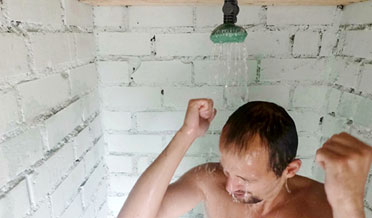Plumbing Repair Issues That Can be the Cause of Not Having Hot Water
Having hot water available at any time has become endemic to life in the US. Often, the first time one realizes hot water is not available is while taking an early morning shower. What a shock!! If it happens to you, where would you start?
The most common source of hot water in an American home is a hot water tank, usually found in an out-of-the-way location—a closet, basement, or garage. The tank, approximately 4 to 5 feet tall, has various pipes and wires from the top and bottom. The most common problem with older water tanks is rust or corrosion. This often results in a large leak. The cold water might be the first indication of a major problem.
But . . . now what? What are the next steps? It might be a little hard to discern this Plumbing Repair problem and find a solution. Here is a Plumbing Repair checklist that might narrow the problem down for a Plumbing Repair technician.
Find the Fuel Source
Is the water heater gas or electric?
- If the water heater is electric, check the electric service panel for the circuit breaker assigned to the tank. Has the breaker tripped? If so, turn the breaker off completely and turn it completely on. If the breaker stays on, this should result in warm water in 30 minutes to one hour. If the breaker trips or the water does not get hot again immediately, call an electrician.
- If the water heater is natural gas, check the supply valve at the tank’s base. An open valve will be parallel to the supply line; a closed valve will be perpendicular to the supply line. If the valve is not completely open, take the following step.
Make Sure the Flame is Lit
Just turning on the gas will not ensure hot water comes from the faucet.
- Some water heaters have an electronic ignition. Turning the gas supply to the ON position should result in a few clicks, and the burner will light. The water should warm up in 30 minutes to one hour.
- Some water heaters have a thermocouple and a pilot light. The thermocouple ensures gas does not enter the home without a flame, so turning on the gas will not have disastrous results. Follow the instructions on the cover for the burner unit.
Check the Thermostat
The AC thermostat on the wall should give a clear understanding of how the water heater thermostat works. The normal factory setting for water heaters is 1400 Fahrenheit. This can be hot enough to scold skin. Since water is heated to this temperature and KEPT at that temp, it takes a lot of energy to maintain. The US Department of Energy recommends a temperature setting of 120 degrees; it is safer for the family and is easier to maintain.
Check the temperature setting. It would be odd that someone changed the thermostat setting without mentioning it, but stranger things have happened.
Check the Volume
The problem could also be an inadequate supply for the need. Hot water tanks come in a variety of sizes, that range between 40 and 80 gallons for residential services since families come in different sizes:
- 40-gallon tanks will serve 2 to 4 persons
- 50-gallon tanks will serve 3 to 5 persons
- 65-gallon tanks will serve 4 to 6 persons
- 80-gallon tanks will serve 6 or more persons
No Hot Water? Call the plumbing repair Experts!
Let Doctor Cool assist with all of your plumbing repair needs. Call Doctor Cool & Professor Heat today at 281-338-8751 or email Doctor Cool and let our professional Residential Plumber Contractors assist with all of your plumbing repair needs.

